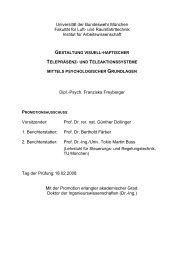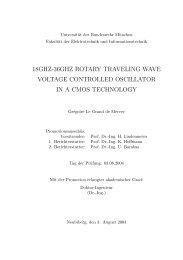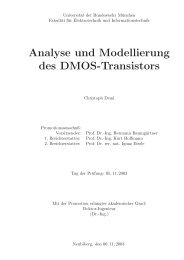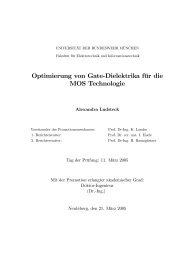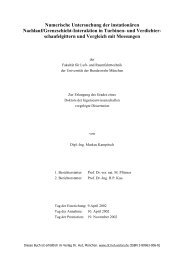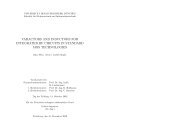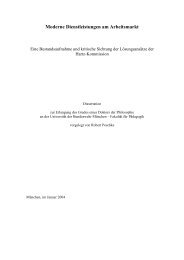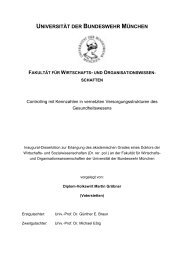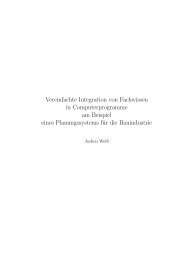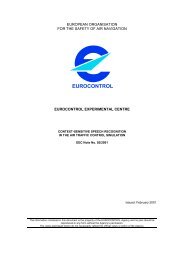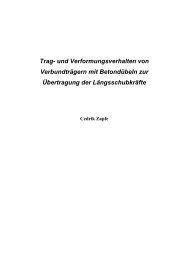Precise Orbit Determination of Global Navigation Satellite System of ...
Precise Orbit Determination of Global Navigation Satellite System of ...
Precise Orbit Determination of Global Navigation Satellite System of ...
Create successful ePaper yourself
Turn your PDF publications into a flip-book with our unique Google optimized e-Paper software.
Chapter 5 Perturbation Models <strong>of</strong> IGSO,GEO and MEO <strong>Satellite</strong>s <strong>Orbit</strong>s<br />
For actual orbit determination, the imperfect <strong>of</strong> the direct radiation model should be considered, therefore some<br />
unmodeled direct radiation errors are estimated during orbit determination. Rewriting Eq.(5-24) as follows<br />
��<br />
ϖ ϖ<br />
ϖ<br />
A<br />
��<br />
2 r − rs<br />
ad = µ �Ps<br />
( 1+<br />
α + α&<br />
∆t)<br />
as<br />
3 �<br />
��<br />
m<br />
ϖ ϖ<br />
(5-39)<br />
| r − rs<br />
| ��<br />
&α can be considered as unmodeled errors <strong>of</strong> reflection coefficient Cr which changes with time. Cr in Eq.(5-24)<br />
can be written as<br />
0<br />
r<br />
1<br />
r<br />
C r = C + C<br />
(5-40)<br />
where<br />
0<br />
Cr<br />
= 1 + α<br />
1<br />
= α& ∆t<br />
C r<br />
i.e. Eq.(5-24) becomes<br />
ϖ ϖ<br />
ϖ A 2 r − rs<br />
ad = µ { Ps<br />
Cr<br />
as<br />
}<br />
m<br />
ϖ ϖ 3<br />
| r − rs<br />
|<br />
ϖ ϖ<br />
ϖ ϖ<br />
0 A 2 r − rs<br />
A 2 r − rs<br />
= µ { Ps Cr<br />
as<br />
} { P<br />
}<br />
3 s t as<br />
m<br />
ϖ ϖ + µ & α∆<br />
3<br />
| r r |<br />
m<br />
ϖ ϖ<br />
(5-41)<br />
−<br />
| r − r |<br />
s<br />
s<br />
In Eq.(5-41), the first term can be calculated by mathematic model like Rock4 (Fliegel et al 1992, McCarthy<br />
1992), the second term is solved during data processing <strong>of</strong> orbit determination.<br />
5.3.2 Effect <strong>of</strong> Eclipses<br />
In order to process the solar direct radiation, another problem, the sun eclipse, should be considered, i.e. how to<br />
process the satellite orbit when satellite is inside the shadow <strong>of</strong> the Earth. The effect <strong>of</strong> the eclipse is a difficult<br />
problem for satellite orbit determination, especially when satellite is in the penumbra. For the eclipse problem,<br />
the simple cylinder model can be used for computation <strong>of</strong> the shadow <strong>of</strong> the Earth. According to this simple<br />
model, for MEO (GPS) satellite, when the angle between the Sun and the +Z direction <strong>of</strong> the SV-body system <strong>of</strong><br />
the satellite, is less than about 14°, the Sun is eclipsed, i.e. the satellite is inside the shadow <strong>of</strong> the Earth; for<br />
IGSO and GEO satellites with about 36000 km altitude from the surface <strong>of</strong> the Earth, the eclipse angle is about<br />
8.6°, i.e. when the angle between the Sun and the +Z direction <strong>of</strong> the SV-body system <strong>of</strong> the satellite is less than<br />
about 8.6°, the satellite is inside the shadow <strong>of</strong> the Earth, see Figure 5-28.<br />
Earth<br />
Direction <strong>of</strong> the Sun<br />
Figure 5-28 The Eclipse Angle <strong>of</strong> IGSO and GEO <strong>Satellite</strong>s<br />
Although this simple model can be used to check if the satellite is in the shadow <strong>of</strong> the Earth, the non-continuity<br />
<strong>of</strong> the solar radiation in force model due to the satellite entering the shadow <strong>of</strong> the earth will have problem in the<br />
orbit integration. During an eclipse, the satellite passes continuously from sunlight to shadow <strong>of</strong> the Earth, but<br />
60<br />
Eclipse angle<br />
<strong>Satellite</strong>



